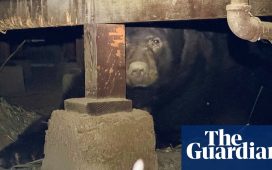Europe’s carnivores have had a remarkable change in fortune. After tens of thousands of years of persecution that wiped out sabretooth tigers, hyenas and cave lions, there has been a recent rebound in the continent’s surviving predators.
Across mainland Europe, bear, wolf, lynx and wolverine numbers have risen dramatically as conservation measures introduced several decades ago have begun to make an impact. There are now about 20,500 brown bears in Europe, a rise of 17% since 2016, while there are 9,400 Eurasian lynx, a 12% increase.
The continent now has 1,300 wolverines, an increase of 16%, while, remarkably, Europe’s population of wild wolves has jumped by 35% to 23,000. Only the golden jackal has done better. Its population – which is concentrated in southern Europe – now stands at 150,000, a rise of 46% since 2016.
Animals that were once hunted as vermin while their habitats were turned to farmland are returning. The howl of the wolf, the grunt of the bear and the noise of their padding through forests and plains is being heard again across Europe.
The century’s most striking continental carnivore comeback is that of the Iberian lynx, or Lynx pardinus. There were fewer than a hundred of these distinctive feline predators 25 years ago, in their last stronghold in southern Spain. Lynx pardinus, a smaller, more brightly coloured relative of the Eurasian lynx, was the most endangered cat on the planet. Today, its status has changed from being “critically endangered” to merely being “vulnerable” as its numbers have soared.
However, saving the lynx required considerable political action and investment that included the introduction of laws in Andalusía to halt indiscriminate snare-laying by landowners; an intense PR campaign aimed at persuading owners of hunting estates to love the lynx; and an initial expenditure of €33m (£28.5m) to fund conservation. This has since been followed up by further investment in work to reintroduce the lynx to other areas of Spain and Portugal, with the bulk from the EU.
It is a striking, heartening story, although it also raises a host of controversial issues that will form the background to this week’s UN biodiversity conference in Rome.
How is Europe going to live with its rising population of wolves, bears and lynx? How can local people be properly compensated for the damage done by predators that attack herds of goats or reindeer? And who should pay that compensation? These are key questions – for the return of European carnivores may delight wildlife lovers but it also threatens to trigger bitter battles between conservationists and local people.
Two years ago, hunters shot dead 54 wolves in a cull in Sweden, prompting fury from conservationists – and satisfaction among local farmers who considered the predators a threat to their livelihoods. But one group of researchers have asked in the run-up to the Rome biodiversity summit: just who is a local?
The group, led by Hanna Pettersson of the Leverhulme Centre for Anthropocene Biodiversity at York University, argue there is a worrying lack of clarity about who is “local” in Europe and this failure is triggering “the introduction of unjust and ineffective strategies for dealing with carnivores”.
It is a particularly European problem. In other parts of the world, indigenous people are given special rights and protections. However, Europe only has one indigenous people: the Sami, who live in land that straddles Sweden, Norway, Finland and Russia.
“For the rest of the continent, the ‘locals’ could include pretty much anyone, making it difficult to understand with whom to work to develop co-existence mechanisms,” Pettersson and colleagues write in their paper which is published this week in the journal People and Nature.
Hotspots for carnivore disruption include the spread of bears in the Pyrenees, wolves in Italy and wolverines in Scandinavia. “The crucial point is that we will soon be dealing with carnivores in an unprecedented way,” added Pettersson. “In the past, we lived with high numbers but it was accepted then that you could keep them at bay with violence and fear. Now we cannot do that. You can’t just go out and shoot a bear or wolf or you might be fined or jailed.
“We are going to have to develop far more flexible strategies that involve local people who can guide us to the best policies for dealing with carnivores in particular places if we want to make sure that their return in Europe is done in a sustainable and fair manner.”
A system that exaggerates the damage caused by a predator will lead to unnecessary and controversial culls, while one that underestimates the problem will inflict unfair hardship on local people by blocking the compensation they deserve for damage caused by predators. “We need to find ways to combine genuine local knowledge with scientific knowledge,” said Pettersson. “At the moment we are not doing that.”













